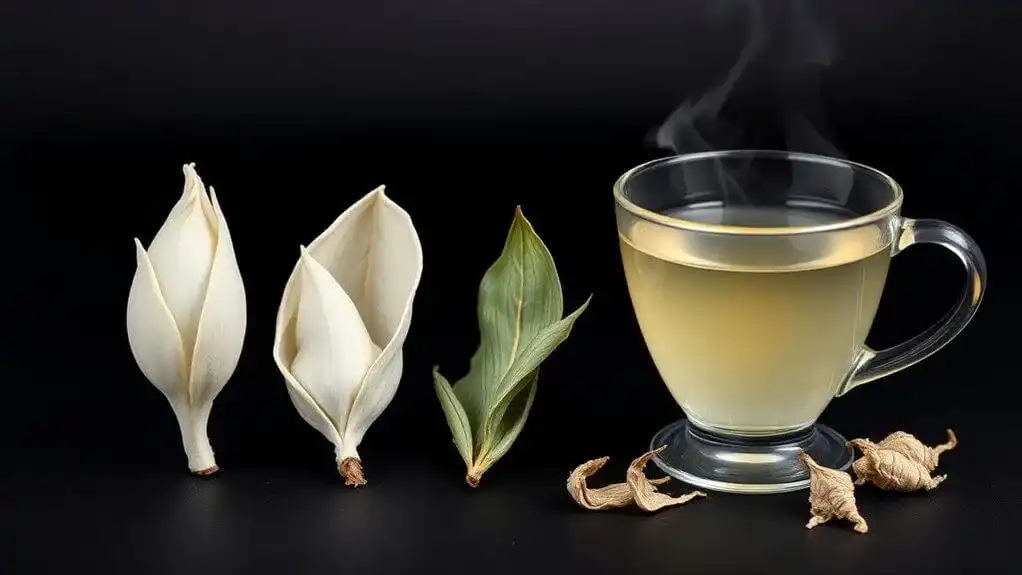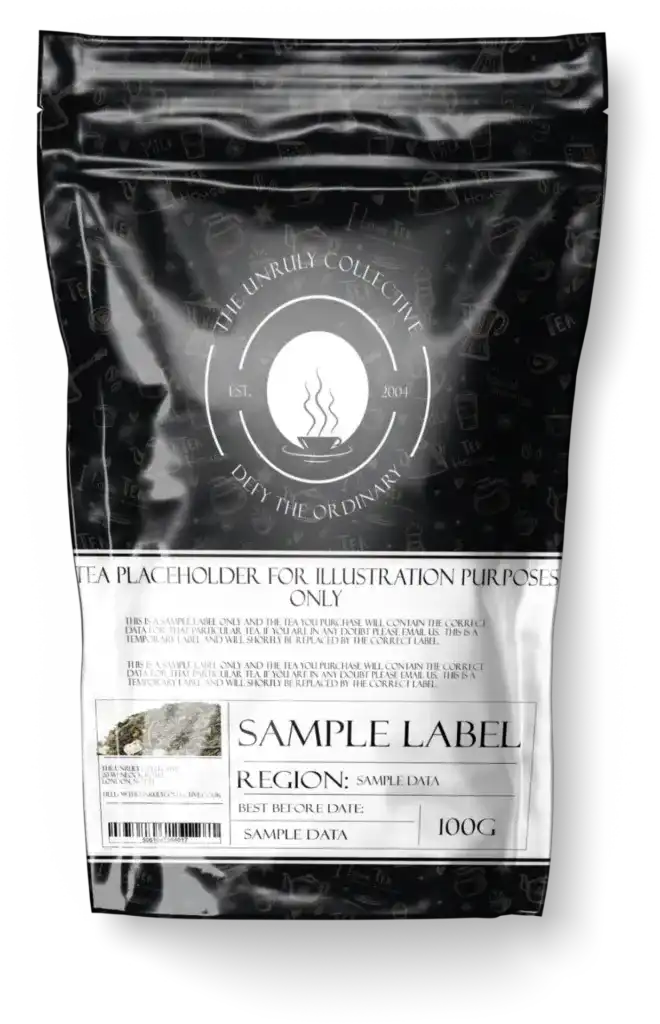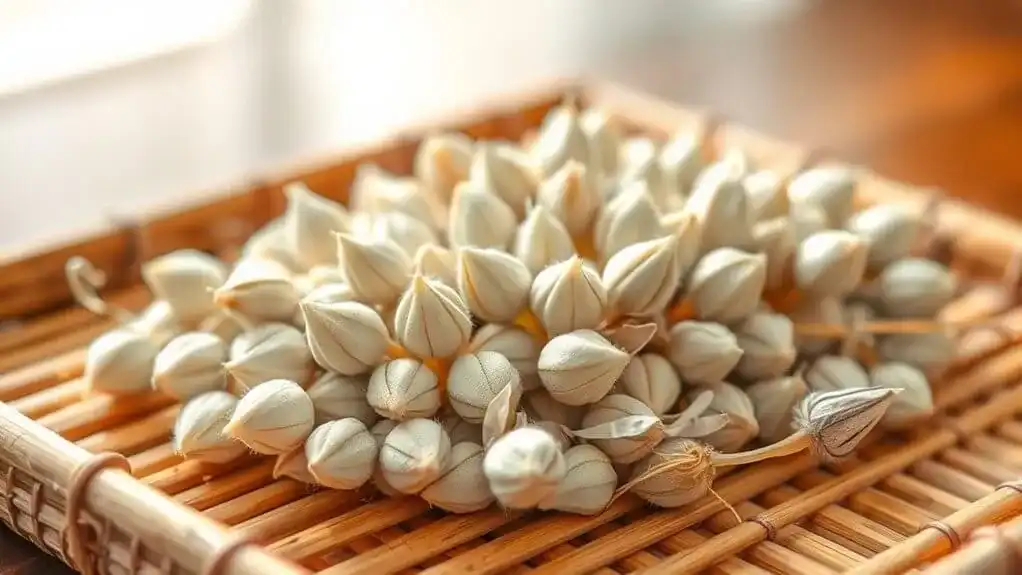Premium white tea undergoes minimal processing, preserving its natural essence through just two main steps. In early spring, skilled harvesters carefully pluck young buds and leaves covered in silvery fuzz, typically in China's Fujian Province. The leaves then undergo natural withering for 48-60 hours, allowing partial oxidation while retaining delicate flavors and beneficial compounds. This simple yet precise process creates one of tea's most sought-after varieties, with each step holding centuries of expertise waiting to be discovered.
Key Points
- Premium white tea is harvested exclusively from tender buds and young leaves during early spring, focusing on unopened or newly opened shoots.
- Skilled harvesters carefully hand-pluck buds with silvery fuzz, placing them in bamboo baskets to prevent bruising and maintain quality.
- Natural withering occurs over 48-60 hours indoors, allowing partial oxidation while preserving delicate aromatics and beneficial compounds.
- Unlike other teas, white tea skips traditional rolling and shaping steps, emphasizing minimal processing to maintain natural characteristics.
- Proper brewing requires specific temperatures (85-95°C) and precise steeping times (1-5 minutes) to extract optimal flavors and aromas.
The Art of Spring Harvesting
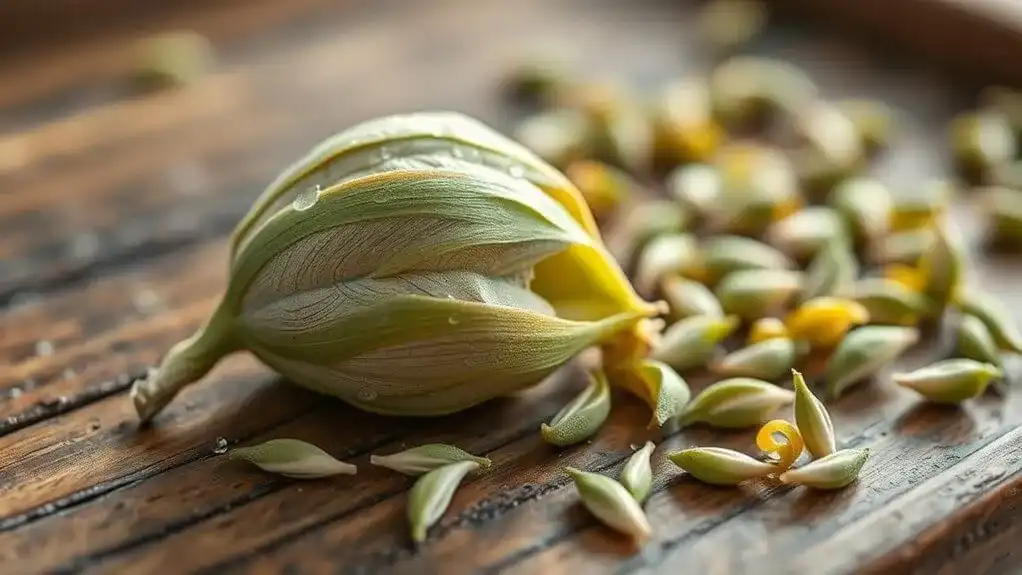
While many teas require careful harvesting, white tea demands an exceptionally meticulous process that begins in early spring. During this season's cool, mild weather, skilled harvesters employ precise spring techniques to gather the youngest, most tender buds and leaves.
The harvesting precision involves expert pickers working in the early morning hours, using either their fingers or special scissors to carefully select unopened buds. They place these delicate leaves in bamboo baskets to protect their quality. The first flush, occurring between March and April, produces the coveted Silver Needle variety, known for its distinctive white, downy buds. The controlled handling process ensures the buds avoid bruising that could trigger unwanted oxidation. Similar to the data preservation techniques used in research data management, careful handling prevents degradation of the tea's quality.
Weather plays a significant role, as harvesters choose sunny, dry days to prevent moisture damage. These ideal conditions allow the skilled workers to select only the finest silver-white velvet leaves for premium white tea. This attention to timing and conditions guarantees the tea maintains its subtle flavors and aromatic compounds.
Natural Withering Process

After the careful spring harvest, white tea leaves undergo a crucial natural withering process that defines their distinctive character. Tea masters employ several withering methods, with indoor withering being the most controlled approach, taking 48 to 60 hours in a well-ventilated environment where natural humidity and ideal airflow are carefully monitored.
On sunny spring and autumn days, producers often utilize a double withering technique that combines indoor and solar methods. The leaves are briefly exposed to gentle sunlight on bamboo mats before being moved indoors to complete the process. During rainy weather, warming equipment helps maintain consistency, reducing withering time to 20-36 hours. The tea leaves gradually turn brown as partial oxidation occurs, a process similar to how cut apples darken when exposed to air. Regardless of method, the goal remains the same: achieving the perfect 8-9% moisture content while preserving the tea's delicate aromatics.
Preserving Nature's Delicate Balance
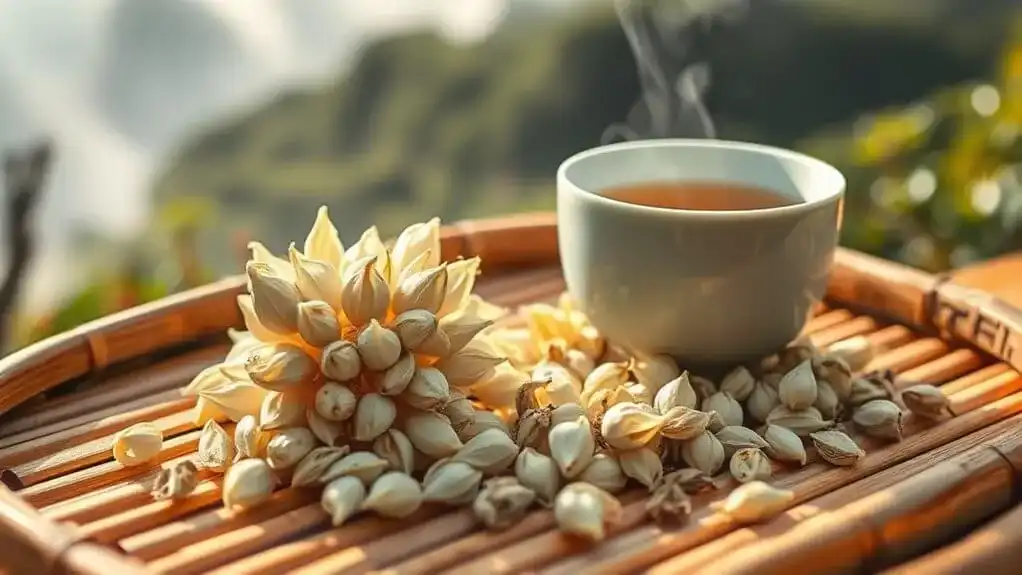
Through meticulous attention to natural processes, white tea production preserves the leaves' delicate enzymatic balance and nutritional compounds. Nature preservation remains at the forefront, as leaves undergo minimal intervention, skipping the traditional rolling and shaping steps that trigger oxidation in other teas. The tea's quality begins with young spring buds carefully selected during early harvest. The withering phase typically requires one to three days to properly develop the tea's main qualities and character.
Unlike green tea's kill-green process, white tea production embraces enzyme retention through gentle, low-temperature drying. The leaves rest undisturbed on bamboo mats, allowing for natural oxidation to slow and cease on its own. This careful approach maintains the tea's rich polyphenols and natural chlorophyll balance while enhancing its subtle aromas. By avoiding excessive heat and mechanical manipulation, the process safeguards the tea's beneficial compounds and delicate flavors, resulting in a product that truly reflects nature's intended expression.
Premium White Tea Characteristics
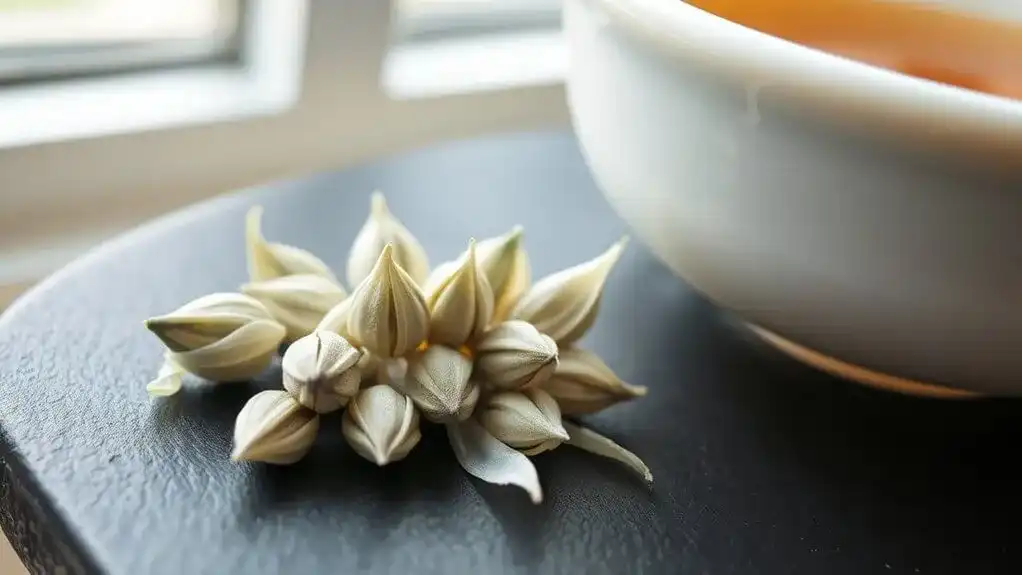
The artful cultivation and minimal processing of white tea culminate in a beverage of remarkable distinction. Its flavor nuances range from delicate floral and honey notes to subtle hints of melon and peach, all while maintaining a light, ethereal character that's best appreciated in quiet contemplation.
Several rarity factors contribute to white tea's premium status:
- It's harvested only during a brief window in early spring
- Each leaf is meticulously hand-plucked while still covered in silvery fuzz
- Production is limited to specific regions, primarily China's Fujian Province
The resulting pale yellow liquor commands high prices, particularly varieties like Silver Needle and White Peony. These prestigious teas showcase the purest expression of the tea leaf, unmarred by extensive processing and celebrated for their refined subtlety. The Yame-produced variety offers distinctive notes of narcissus and sweet corn, creating a unique flavor profile among premium white teas.
Brewing Methods for Perfect Results
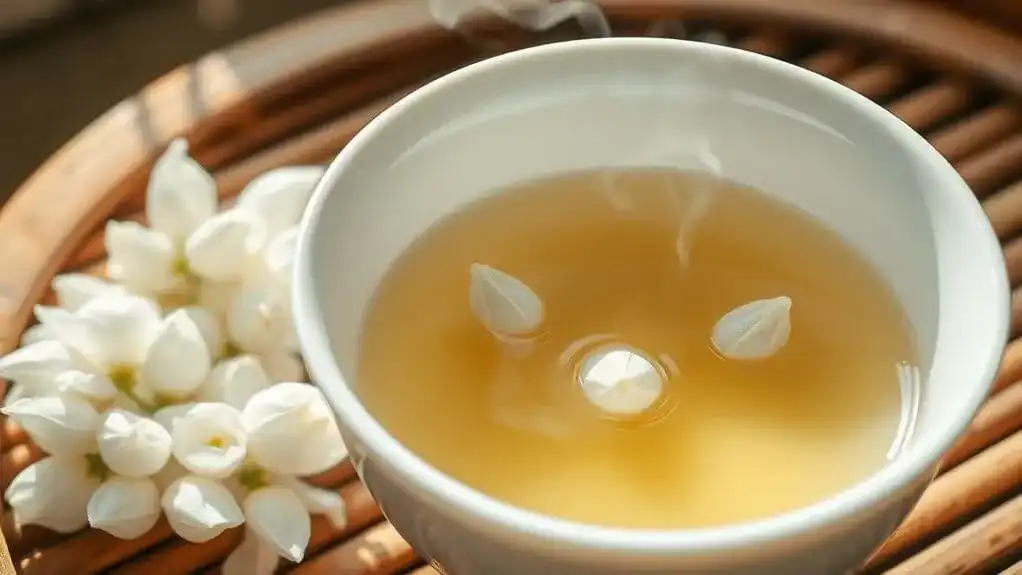
Mastering the art of brewing white tea requires precise attention to temperature, timing, and technique. The key to revealing its delicate flavor profiles starts with water quality – spring or filtered water heated to specific temperatures: 85°C for Silver Needle, 90°C for White Peony, and 95°C for aged varieties. Pure mineral water enhances the natural sweetness of the tea and creates a more balanced taste.
Different brewing techniques enhance the tea's character. Silver Needle needs 2 teaspoons per 6 ounces of water, while White Peony requires 2 tablespoons. Originally reserved for Chinese emperors, this premium tea deserves careful preparation to honor its noble heritage. A quick warm water rinse removes dust and awakens the tea's aroma. For a refreshing alternative, you can prepare tea using cold water infusion. Steeping times vary from 1-5 minutes, with regular taste testing every 30 seconds after the first minute. Using a Gaiwan, tea enthusiasts can achieve multiple infusions by pouring water along the sides and gently shaking to release the aroma. Each pour should completely drain to prevent over-steeping.
Cultural Heritage and Traditional Methods
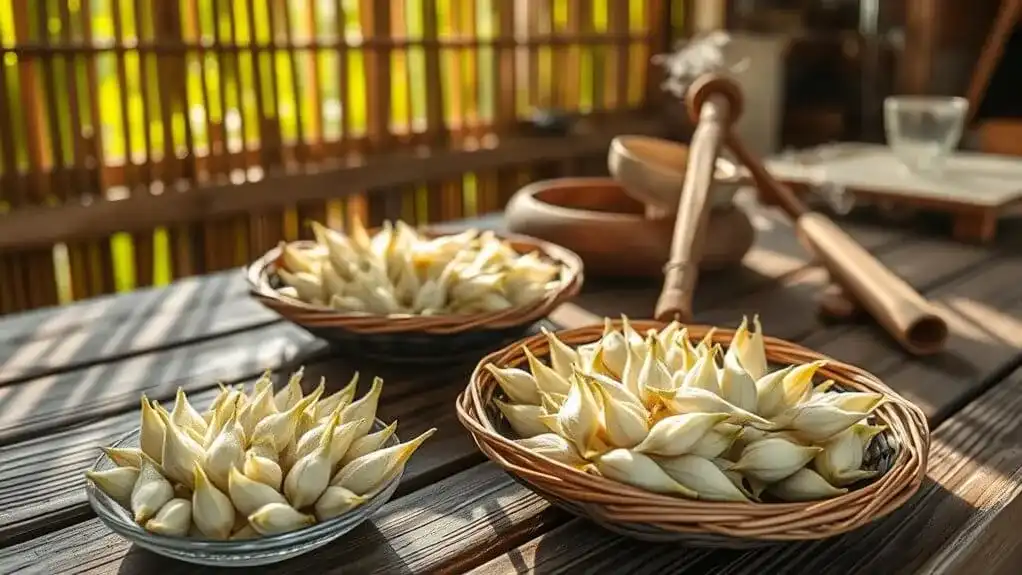
Deeply rooted in Chinese history, white tea's cultural significance spans over a millennium, originating in the Tang Dynasty and reaching its pinnacle during the Song Dynasty. Once exclusively reserved for the imperial court, this rare beverage represents the epitome of Chinese tea craftsmanship, now recognized by UNESCO as Intangible Cultural Heritage.
The cultural symbolism of white tea is preserved through:
- Traditional ceremonial practices that reflect royal heritage
- Regional specialties from Fujian Province, including prized Silver Needle and White Peony varieties
- Natural processing methods that honor ancestral techniques
Today's preservation efforts focus on protecting traditional landrace teas, particularly in Fuding, where local varietals like Fuding Dabai continue to thrive. Modern scientific research complements these cultural practices, ensuring white tea's legacy endures for future generations. Since 1985, over thirty new cultivars have been developed through crossbreeding efforts to enhance the diversity of white tea production.
Environmental Impact and Sustainability
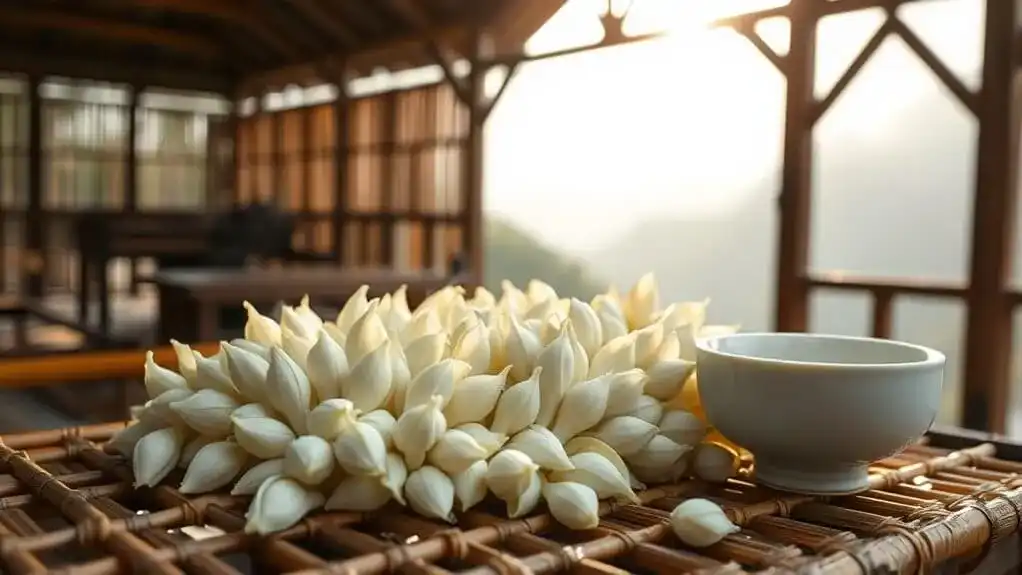
While premium white tea production traditionally requires minimal processing, modern cultivation practices can pose significant environmental challenges. Large-scale plantations can disrupt local ecosystems and contribute to biodiversity loss, while conventional farming methods often rely on harmful synthetic pesticides and fertilizers. These intensive practices have led to concerning issues with water contamination and runoff. High-altitude tea gardens naturally support pesticide-free cultivation, making them ideal locations for sustainable production.
To address these concerns, many tea producers are adopting sustainable practices that prioritize environmental conservation. Organic farming methods eliminate synthetic chemicals, protecting soil health and water quality. Efficient irrigation systems help conserve water resources, while agroforestry techniques support biodiversity and carbon sequestration. Some producers also implement composting programs to minimize waste and enrich soil naturally. Fair trade certification ensures tea farmers receive equitable compensation while promoting environmentally responsible cultivation methods.
Consumers can support these eco-friendly initiatives by choosing certified organic and sustainably produced white teas, encouraging industry-wide adoption of responsible farming practices.
The Role of Expert Tea Masters
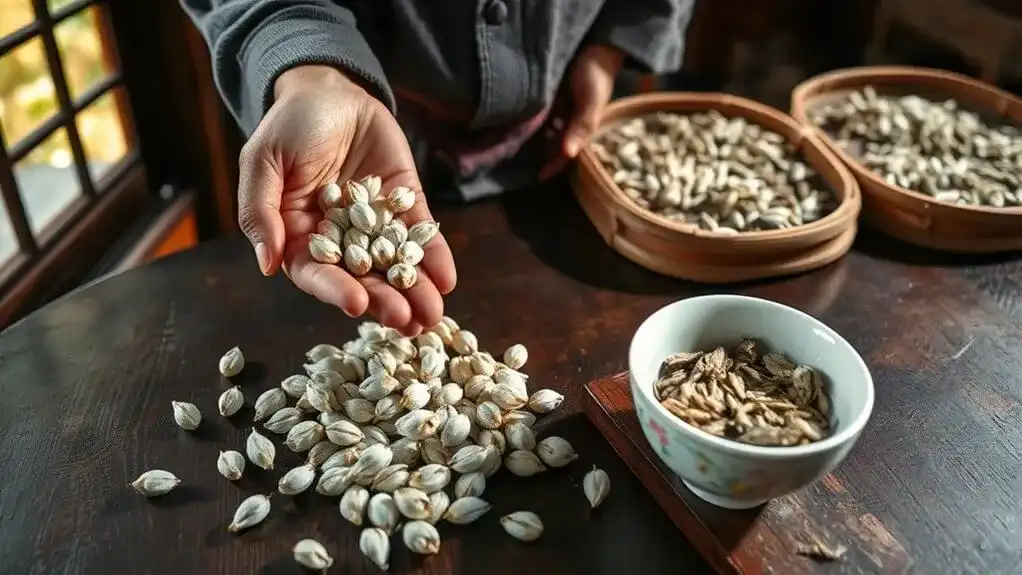
The art of premium white tea production rests firmly in the hands of expert tea masters, whose refined skills and meticulous attention to detail guide every step of the process. Tea Mastery demands years of experience to develop the sensitivity needed for detecting subtle changes in withering leaves and responding appropriately to environmental conditions. This expertise is particularly evident in Fujian Province, China, where the majority of premium white tea is produced. Processing must be carefully timed to occur late morning after the morning dew has dried from the leaves for optimal quality.
Mastering traditional Withering Techniques requires:
- Sharp sensory skills to monitor leaf color, shape, and aroma changes
- Deep understanding of various tea cultivars and their specific requirements
- Quick decision-making ability to adjust conditions and prevent quality issues
Expert tea masters like Master Ye, a cultural heritage representative, demonstrate how this craft depends on precise judgment and careful orchestration. Their role is particularly vital in white tea production, where even minor errors can result in subpar quality, making their expertise invaluable to maintaining premium standards.
Global Market and Consumer Appreciation

Premium white tea's market presence has surged greatly, reaching USD 2.13 billion in 2024 with projections indicating growth to USD 3.42 billion by 2032. The market is expected to grow at a CAGR of 5.15% through 2028. This impressive growth reflects shifting consumer preferences toward healthier, premium beverage options, particularly in Europe where health and personal grooming awareness drives demand. Consumers increasingly show willingness to invest in high-quality and artisanal tea products. Strategic channel expansion through e-commerce platforms has significantly boosted accessibility to premium white tea products globally.
Market trends show increasing appreciation for white tea's antioxidant and antibacterial properties, with the organic segment experiencing significant expansion. Leading companies like Zhejiang Tea Group Co., Ltd. and Dilmah Ceylon Tea Company PLC have responded by adjusting their pricing strategies and product differentiation to meet regional preferences. The Asia-Pacific region presents substantial growth opportunities due to rising disposable incomes and changing consumer behavior, while applications expand beyond beverages into cosmetics, toiletries, and pharmaceuticals.
Conclusion
Premium white tea's pristine processing preserves its pure, potent properties. From the perfectly-timed plucking to the mindful monitoring of master tea makers, white tea's wonderful wholesome qualities continue to captivate connoisseurs worldwide. Today's thoughtful tea traditions honor heritage while embracing sustainable solutions. As this delicate drink delights more discerning drinkers globally, it's clear that white tea's minimal processing maintains its maximum magic.
